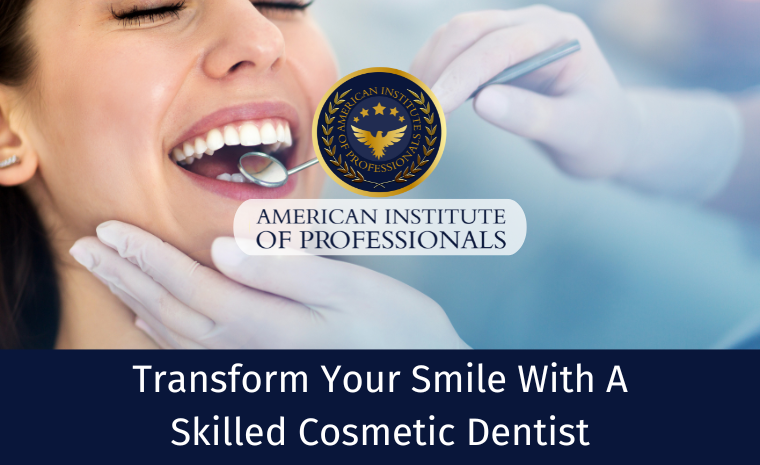A smile is a powerful expression that transcends language and cultural barriers. It can convey joy, warmth, and approachability. Beyond its aesthetic appeal, a beautiful smile holds immense importance in shaping an individual’s confidence and self-esteem.
The way we feel about our smiles can significantly influence how we perceive ourselves and interact with the world around us. Whether it’s the alignment of our teeth, the brightness of our smile, or the overall oral health, a beautiful smile plays a vital role in boosting self-assurance and leaving a lasting impression on others.
Looking for a smile makeover?

Understanding Cosmetic Dentistry
Cosmetic dentistry refers to the branch of dentistry that focuses on improving the aesthetic appearance of a person’s teeth, gums, and smile. It involves various dental procedures and treatments aimed at enhancing the aesthetic aspects of a person’s oral appearance rather than solely focusing on oral health functionality. While these cosmetic dentistry procedures primarily deal with the visual aspects of dental care, it often incorporates techniques and materials that also promote oral health.
What is the Purpose of Cosmetic Dentistry?
The purpose of cosmetic dentistry is to help individuals achieve the smile they desire, addressing any imperfections or concerns they may have about their teeth or gums. It goes beyond maintaining oral hygiene and health by focusing on the overall appearance of the smile. Cosmetic procedures can correct issues such as discolored teeth, misaligned teeth, gaps, chips, cracks, and irregularities in shape or size.
Cosmetic dentistry procedures can vary widely depending on the specific needs and goals of the patient. Here are some of the most common cosmetic dental procedures:
- Teeth Whitening – Teeth whitening, also known as teeth bleaching, is a common procedure to lighten the color of teeth that have become stained or discolored. It can be done in-office by a dentist or at home using custom-made trays and professional-grade whitening gel.
- Dental Veneers – Veneers are thin, custom-made shells that are bonded to the front surface of teeth to improve their appearance. They can be used to correct a variety of issues, including discoloration, chipped or cracked teeth, gaps, and minor misalignment. Veneers may also be an alternative to crowns.
- Dental Bonding – Dental bonding involves applying a tooth-colored material (made of resin) to the teeth and then shaping and polishing it to improve the appearance of chipped, cracked, or discolored teeth. It is a cost-effective and minimally invasive procedure.
- Dental Crowns – Dental implants are used to replace missing teeth. They consist of an artificial tooth root that is surgically placed into the jawbone, providing a strong foundation for a replacement tooth (crown) that looks and functions like a natural tooth.
- Orthodontic Treatments – Orthodontic treatments, such as braces or clear aligners (e.g., Invisalign), are used to correct misaligned or crooked teeth. These treatments gradually move teeth into the desired position, resulting in a straighter smile and improved bite alignment.
- Dental Crowns – Dental crowns, also known as dental caps, are tooth-shaped coverings that are placed over damaged or heavily decayed teeth to restore their appearance, strength, and functionality. They can also be used to improve the size and color of misshapen teeth.
- Gum Contouring – Gum contouring, also called gum reshaping or gum lifting, is a procedure that involves removing excess gum tissue to create a more balanced and aesthetically pleasing gum line. It is often done to correct a “gummy smile” or to even out the gum line.
Benefits of Cosmetic Dentistry
Cosmetic dentistry offers a range of benefits that can significantly improve a person’s smile, confidence, and overall quality of life. Some of the key benefits of cosmetic dentistry include enhancing smile aesthetics, correcting dental imperfections, enhancing dental functionality, and preserving natural teeth.
Cosmetic dentistry helps individuals improve their self-confidence through a gorgeous smile. Having a pleasing smile helps increase opportunities by creating a positive first impression in personal, social, and professional settings. These can help patients gain confidence in job interviews, networking events, or personal relationships.
Potential Risks and Limitations of Cosmetic Dentistry
While cosmetic dentistry procedures are generally safe and effective, it’s important to consider potential risks and limitations before undergoing any dental treatment. The following are some common risks and limitations associated with cosmetic dentistry:
1. Sensitivity – Teeth sensitivity can be a temporary side effect of certain aesthetic dentistry procedures, such as teeth whitening. While it usually subsides after a short period, it can cause discomfort during the treatment or when consuming hot or cold substances.
2. Irritation or allergic reactions – Some individuals may experience irritation or allergic reactions to the materials used in these procedures, such as dental bonding materials or metal used in dental restorations. It’s important to discuss any known allergies or sensitivities with your cosmetic dentist beforehand.
3. Irreversible changes – Some cosmetic dentistry procedures involve irreversible changes to the natural teeth. For example, removing a thin layer of natural enamel for veneer placement cannot be undone.
4. Unsatisfactory results – While cosmetic dentistry aims to achieve desired aesthetic outcomes, there is a possibility of not achieving the exact desired results. Have realistic expectations and communicate openly with your dentist about your goals and preferences.
5. Impact on oral health – While cosmetic treatment focuses on improving the appearance of teeth, ensure that underlying oral health issues are addressed. Prioritizing oral care is crucial, as some cosmetic procedures may not be suitable if there are untreated oral health problems, such as gum disease or tooth decay.
The Role of a Cosmetic Dentist
The primary focus of a cosmetic dentist is to enhance the visual aspects of a person’s smile while considering their overall oral health. A cosmetic dentist begins by conducting a thorough smile analysis, evaluating the patient’s teeth, gums, lips, and facial structure. They assess the individual’s specific concerns, goals, and expectations to develop a personalized treatment plan tailored to their unique needs.
Your dentist will then provide detailed consultations to educate patients about the available treatment options and help them make informed decisions. They explain the benefits, risks, and limitations of each procedure, as well as the expected outcomes, timeline, and cost involved.
One of the most important roles of a cosmetic dentist is their expertise in aesthetics and skill in creating personalized smiles that suit the unique facial features and individual preferences of each patient. They take into account factors such as tooth color, shape, size, symmetry, and overall harmony with the patient’s facial characteristics.
Hire a Skilled Cosmetic Dentist
In conclusion, entrusting a cosmetic dentist to help transform your smile can be a life-changing decision. With their expertise in dental aesthetics and advanced techniques, cosmetic dentists can address a wide range of aesthetic concerns and provide personalized treatment plans tailored to your unique needs and goals.
Whether it’s teeth whitening, dental veneers, dental implants, or other procedures, a cosmetic dentist has the skills and knowledge to create natural-looking results that harmonize with your facial features and bring out your best smile.
Remember, each smile transformation is unique, and finding the right cosmetic dentist who understands your goals and communicates effectively is crucial. By collaborating with a skilled cosmetic dentist, you can embark on a transformative journey toward a radiant and captivating smile that truly reflects your inner beauty.





